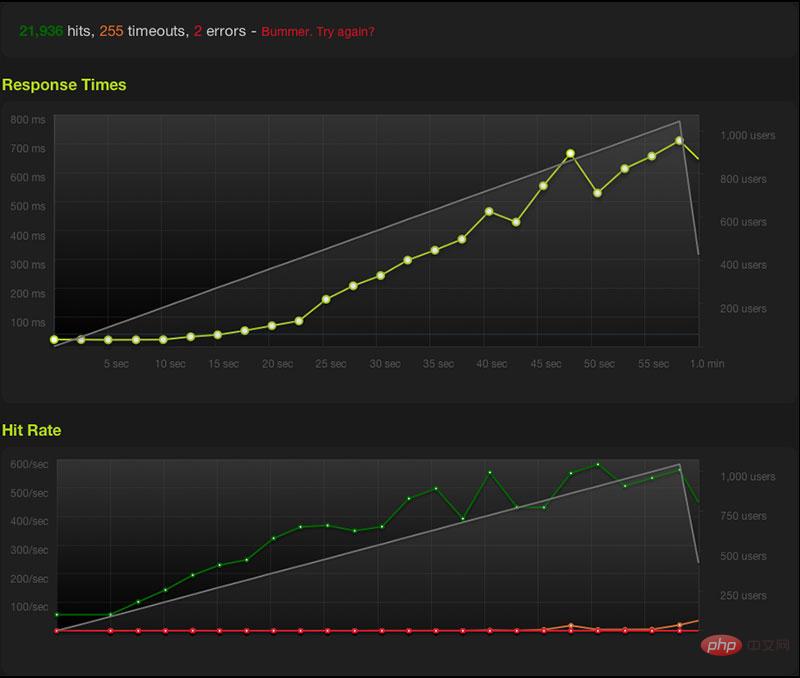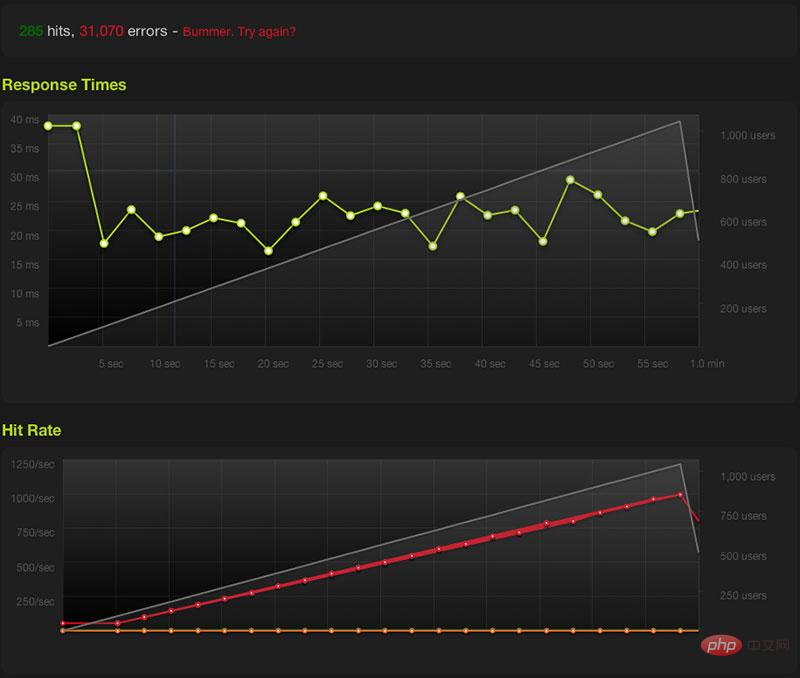How to configure Nginx server to prevent Flood attacks
Test
I will briefly tell you how to configure nginx's restricted request module and how it protects your website from being attacked by DDoS or other http-based Denial of service attack.
In this test, I saved the sample page in blitz.io (now a free service) and named it about.html to test the limit_req directive.
First, I saved it on blitz Use the following command to initiate 1075 concurrent requests and last for one minute. The response timeout is set to 2 minutes, the region is California, and all other states except status 200 are set to abnormal status. Even 503 is considered It was unsuccessful.
-p 1-1075:60 --status 200 -t 2000 -r california http://kbeezie.com/about.html

Ran Zhou defines these rules in the server:Copy the code The code is as follows:location = /about.html {
limit_req zone=blitz nodelay;
}
Then reload the nginx configuration and see the effect:

php Apply Request Limits
If you want to restrict all For PHP application limits, you can do this: Copy code The code is as follows:location ~ \.php { limit_req zone=flood;
include php_params.conf;
fastcgi_pass unix:/tmp/php5-fpm.sock;
}
Note:
It is difficult for me to implement a real high-traffic network or ddos (distributed denial of service attack). This is why the number of users we successfully access is not the same as ip Very large. Server load will also affect the number of visits or regions of test users. With the free version, the maximum number of concurrent users you can access is 50. Of course, you can spend $49 per day to allow 1,000 users to visit your website.
Better alternative
Without going into more details here, if you are serious about preventing DDoS or multi-service attacks from attacking your server, there are other great software tools like iptables (linux), pf (packet filter for bsd), or if your server provides hardware, you can use your hardware firewall. The above restriction module will only prevent flood attacks through http requests. It will not prevent ping packet flood attacks or other vulnerabilities. For these In this case, you can close unnecessary services and unnecessary ports to prevent others from breaking through.For example, the only ports my server exposes to the external network are http/https and ssh. Among services such as mysql Bind local connections. You can also set some common services to ports that are not commonly used so that they will not be sniffed (iptables/pf will help in this situation).The above is the detailed content of How to configure Nginx server to prevent Flood attacks. For more information, please follow other related articles on the PHP Chinese website!

Hot AI Tools

Undresser.AI Undress
AI-powered app for creating realistic nude photos

AI Clothes Remover
Online AI tool for removing clothes from photos.

Undress AI Tool
Undress images for free

Clothoff.io
AI clothes remover

AI Hentai Generator
Generate AI Hentai for free.

Hot Article

Hot Tools

Notepad++7.3.1
Easy-to-use and free code editor

SublimeText3 Chinese version
Chinese version, very easy to use

Zend Studio 13.0.1
Powerful PHP integrated development environment

Dreamweaver CS6
Visual web development tools

SublimeText3 Mac version
God-level code editing software (SublimeText3)

Hot Topics
 How to allow external network access to tomcat server
Apr 21, 2024 am 07:22 AM
How to allow external network access to tomcat server
Apr 21, 2024 am 07:22 AM
To allow the Tomcat server to access the external network, you need to: modify the Tomcat configuration file to allow external connections. Add a firewall rule to allow access to the Tomcat server port. Create a DNS record pointing the domain name to the Tomcat server public IP. Optional: Use a reverse proxy to improve security and performance. Optional: Set up HTTPS for increased security.
 How to run thinkphp
Apr 09, 2024 pm 05:39 PM
How to run thinkphp
Apr 09, 2024 pm 05:39 PM
Steps to run ThinkPHP Framework locally: Download and unzip ThinkPHP Framework to a local directory. Create a virtual host (optional) pointing to the ThinkPHP root directory. Configure database connection parameters. Start the web server. Initialize the ThinkPHP application. Access the ThinkPHP application URL and run it.
 Welcome to nginx!How to solve it?
Apr 17, 2024 am 05:12 AM
Welcome to nginx!How to solve it?
Apr 17, 2024 am 05:12 AM
To solve the "Welcome to nginx!" error, you need to check the virtual host configuration, enable the virtual host, reload Nginx, if the virtual host configuration file cannot be found, create a default page and reload Nginx, then the error message will disappear and the website will be normal show.
 How to register phpmyadmin
Apr 07, 2024 pm 02:45 PM
How to register phpmyadmin
Apr 07, 2024 pm 02:45 PM
To register for phpMyAdmin, you need to first create a MySQL user and grant permissions to it, then download, install and configure phpMyAdmin, and finally log in to phpMyAdmin to manage the database.
 How to communicate between docker containers
Apr 07, 2024 pm 06:24 PM
How to communicate between docker containers
Apr 07, 2024 pm 06:24 PM
There are five methods for container communication in the Docker environment: shared network, Docker Compose, network proxy, shared volume, and message queue. Depending on your isolation and security needs, choose the most appropriate communication method, such as leveraging Docker Compose to simplify connections or using a network proxy to increase isolation.
 How to deploy nodejs project to server
Apr 21, 2024 am 04:40 AM
How to deploy nodejs project to server
Apr 21, 2024 am 04:40 AM
Server deployment steps for a Node.js project: Prepare the deployment environment: obtain server access, install Node.js, set up a Git repository. Build the application: Use npm run build to generate deployable code and dependencies. Upload code to the server: via Git or File Transfer Protocol. Install dependencies: SSH into the server and use npm install to install application dependencies. Start the application: Use a command such as node index.js to start the application, or use a process manager such as pm2. Configure a reverse proxy (optional): Use a reverse proxy such as Nginx or Apache to route traffic to your application
 How to generate URL from html file
Apr 21, 2024 pm 12:57 PM
How to generate URL from html file
Apr 21, 2024 pm 12:57 PM
Converting an HTML file to a URL requires a web server, which involves the following steps: Obtain a web server. Set up a web server. Upload HTML file. Create a domain name. Route the request.
 What to do if the installation of phpmyadmin fails
Apr 07, 2024 pm 03:15 PM
What to do if the installation of phpmyadmin fails
Apr 07, 2024 pm 03:15 PM
Troubleshooting steps for failed phpMyAdmin installation: Check system requirements (PHP version, MySQL version, web server); enable PHP extensions (mysqli, pdo_mysql, mbstring, token_get_all); check configuration file settings (host, port, username, password); Check file permissions (directory ownership, file permissions); check firewall settings (whitelist web server ports); view error logs (/var/log/apache2/error.log or /var/log/nginx/error.log); seek Technical support (phpMyAdmin






